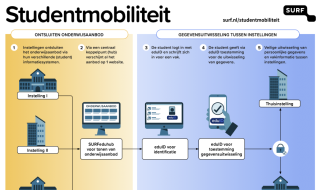Flexible education organisation
Student mobility
Taking courses at other institutions becomes the norm
We want to make it a lot easier for students to take courses at other educational institutions. In such a way that students remain in control of their data, thus protecting their privacy. That is why SURF, in collaboration with institutions, has developed an infrastructure consisting of 3 main components:
- orienting to educational offers
- registering for an educational offering
- feedback of the result afterwards
What does the infrastructure look like?

Infographic on student mobility infrastructure
Infographic on student mobility infrastructure
Component 1: Making educational resources available
It is important for institutions to make their educational resources available in a unified way, so that the total range of courses on offer can be easily displayed online. Using the Open Education API(OOAPI) standard, institutions unlock the range of courses on offer in their (student) information systems. To achieve this, the institutions have implemented an OOAPI endpoint that brings all the data of the educational offering together.
Component 2: Publishing educational resources
Via SURFeduhub, all data from the OOAPI endpoints are routed to platforms that want to display the information. For this pilot, this is the website eduXchange.nl, but it can also be other portals that connect to SURFeduhub. To view the offerings on eduXchange.nl, students do not need to log in. This information is freely available on the internet.
Sections 3 and 4: Registration by the student
Students register with eduID. eduID is used to make the login and registration process as privacy-friendly as possible. The student logs in with eduID at the host institution where she will take the course. She thereby gives explicit permission for the host institution to retrieve from the home institution the data needed for registration, and permission for the result to be reported back later.
Component 5: Data exchange between institutions
After the student has given permission, the host and home institutions can securely exchange the student's personal data, and the data of the course for which she is enrolling. To exchange the data, each institution uses software developed by SURF, a combination of eduID and the OOAPI standard.
SURF's Jocelyn Manderveld explains how the Student Mobility pilot came about and the infrastructure we built.
Read the blog
The Open Education API is an open standard for sharing education data. Through this API, educational institutions make useful information available via apps, for example, grade and timetable information. The open standard is powered by SURF.

The infrastructure is now ready, so we are ready to test it in practice. The UU, TU/e and WUR are experimenting within the Student Mobility project of the Flexibilisation zone of the Acceleration Plan with the exchange of educational supply data within SURF's infrastructure. A new alliance with TU Delft, Leiden University, Erasmus University will also start the pilot in 2022. Based on the pilot, SURF will further develop the infrastructure to enable expansion and upscaling.
Read more on the website of Versnellingsplan